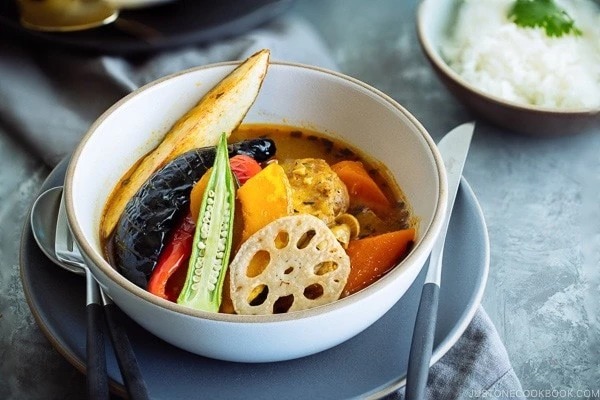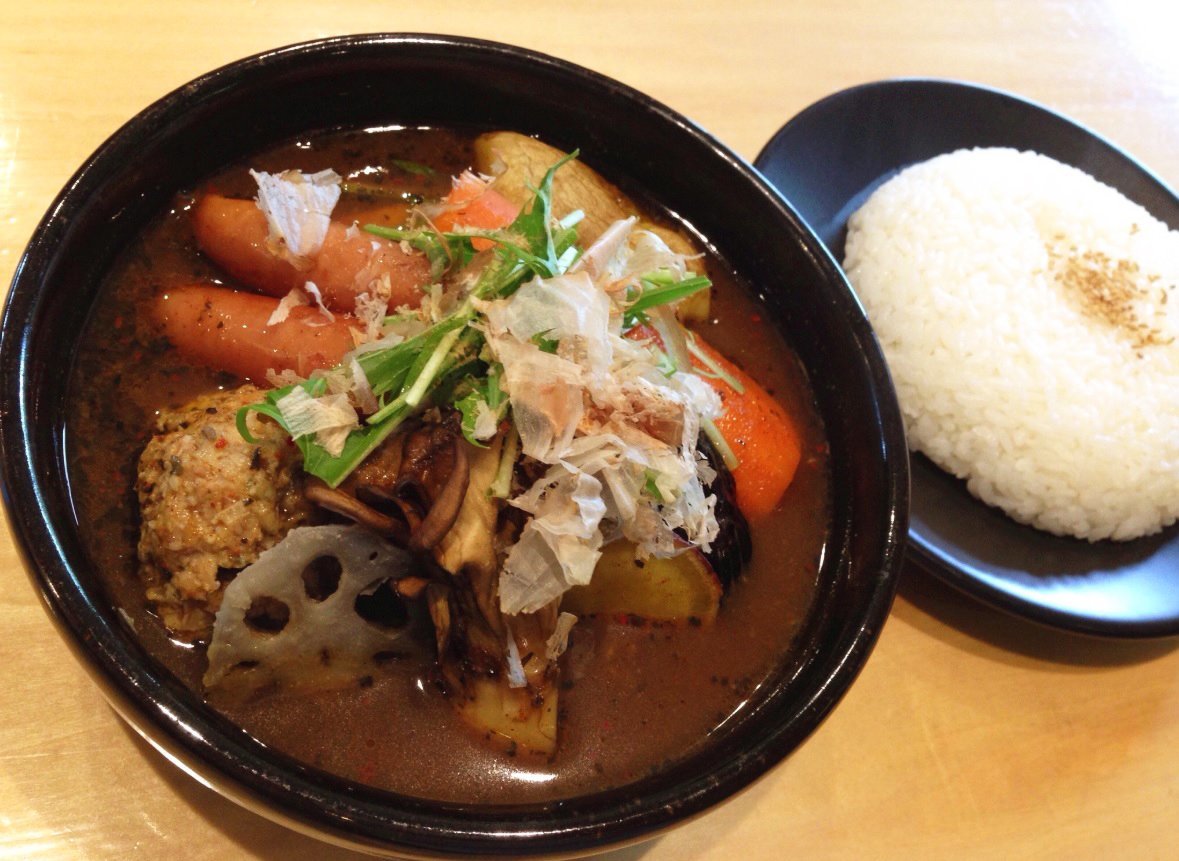Hokkaido Soup Curry Recipe #StayAtHome
These days, many people around the world are choosing [or are being ordered] to stay home during the COVID-19 pandemic to stay safe and flatten the curve of the unprecedented virus. It's a time where working from home, relaxing indoors and having extra time for hobbies and homely tasks are now the norm in a world where it usually seemed impossible to find spare hours in the day.
While some are taking it back to basics with analogue entertainment like puzzles, art or card games, others are using the spare time at home to improve their skills in areas they previously could never find time to concentrate on: musical instruments, web development, getting fit or even something as simple as cooking.
So if you're one who's looking to become the next Julia Child, Jamie Oliver or Harumi Kurihara while stuck at home, check out the recipe below for one of Hokkaido's most beloved regional dishes: soup curry.

Hokkaido soup curry originated in Sapporo [the prefecture's capital] in the 70's, and uses a combination of broth and traditional Indian/Nepalese curry spices to create a wonderful soup that is warm, hearty and spicy [if you choose]. Arranged on top of the soup is a piece of meat and vegetables - the combination of these ingredients typically determines the signature style of the restaurant - as well as a few other ingredients that highlight the prefecture's prosperous harvests and delicious natural produce.

You can find the following ingredients in a typical bowl of Hokkaido soup curry:
- a tender leg of chicken that has been slow cooked to perfection OR
- a delicious tsumire chicken meatball with lots of herbs and flavour
- carrot
- potato and/or pumpkin
- firm tofu
- lotus root
- Japanese mushrooms like maiitake, shimeji or shiitake
- eggplant
- onion
- greens such as bell peppers, okra or green onion
While not as rich or heavy as traditional Japanese or Indian curries that have a gravy-like texture, soup curry is distinct in its thinner consistency and its assembly of vegetables [most of them] and meat on top of the liquid rather than being cooked in it.
The result is a yōshoku [Japanese cuisine that has been adapted from other cultures] dish that reflects the eating habits of people living in the cold climate of Hokkaido and has become a beloved 'must-eat' dish on any trip to the great north. Another characteristic of the beloved meal is it's customizability - with endless combinations of meat and vegetables to add onto the soup, it really can be anything you want it to be - vegetarian/vegan, creamy with coconut milk, extra spicy with fresh chilies or with an extra protein boost like bonito flakes or boiled egg.

No matter how you choose to enjoy soup curry, one factor that will undoubtedly result in a tasty bowl is making sure the ingredients are good quality - fresh, in season produce and tender, ethical meat will naturally result in an incredible meal.
While it's not the quickest or simplest of recipes [it does require multiple techniques that a novice chef may not have used before], soup curry is an incredibly hearty and satisfying meal with potential to enjoy for many meals afterwards with a simple reheating. The below recipe is by Just One Cookbook, which is a food blog run by Nami, a Japanese home cook living in San Francisco. Many of her recipes have been tried by our staff and turned out great! Most of her recipes can be done with regular pantry items and a few key ingredients found at an Asian grocer. Be sure to also check out her recipes for nikujaga stew, gyudon, teriyaki chicken and curry udon - they're super simple and very delicious!
Nami used a multi-use pressure cooker [Cuckoo brand] for this recipe, but if you don't have one, the dish can easily be adapted by using the following:
- Rice cooker or stovepot for fresh rice.
- A large pot on medium heat for browning the chicken and cooking the soup curry. Once the basil and bay leaf are added to the mix, cover the pot and cook at a gentle simmer for ~30 minutes or until the mushrooms/carrots are soft and the chicken is fully cooked-through.
Hokkaido Soup Curry Recipe
Prep Time: 20 mins Cook Time: 1 hr 20 mins Total Time: 1 hr 40 mins Servings: 4
Ingredients
For Steamed Rice:
- 2 rice cooker cups uncooked Japanese short-grain rice, rinsed in a sieve until water runs clear
- water [a ratio of roughly 1:1.5 rice-to-water works best]
For Soup Curry:
- 1 onion
- 1 carrot
- 1 package shimeji mushrooms
- 3 cloves garlic
- 1 knob ginger
- 2.5 lb bone-in skin-on chicken thighs (6 pieces)
- 1 tsp kosher/sea salt (use half for table salt) (for chicken)
- freshly ground black pepper
- ½ Tbsp extra virgin olive oil
- 1 Tbsp unsalted butter
- ¼ tsp kosher/sea salt (use half for table salt) (for onion)
- 3 cups chicken stock/broth
- 1 Tbsp dry basil
- 1 bay leaf
- 1 tsp kosher/sea salt (use half for table salt) (to taste)
- 1 tsp soy sauce
Seasonings:
- 1 piece Japanese curry roux (= 1 small square block)
- 1 Tbsp curry powder
- 1 tsp garam masala
- 1 Tbsp tomato paste
- 1 Tbsp honey
- 1 ½ Tbsp mango chutney
For Additional Vegetables:
- 1 cup neutral-flavored oil (vegetable, canola, etc)
- 1 russet potato
- ½ red bell pepper
- 2 okra
- 2 Japanese/Chinese eggplant or 1/2 large eggplant
- 2 inches lotus root (renkon)
- 2 oz kabocha (squash/pumpkin) (60 g)
Method
Make rice:
- Prepare steamed rice using your preferred method.
Prepare Ingredients:
- Gather all the ingredients. Once we start cooking, we don't have time to measure, so make sure to prepare the seasonings ahead of time (1 piece Japanese curry roux, 1 Tbsp curry powder, 1 tsp garam masala, 1 Tbsp tomato paste, 1 ½ Tbsp mango chutney, and 1 Tbsp honey).
- Dice the onion (It doesn’t have to be perfect).
- Cut the carrot into small pieces. I recommend using “rangiri” – a Japanese cutting method to increase the surface. It’ll help cooking evenly and faster, and absorbing more flavors.
- Mince the garlic and grate the ginger.
- Discard the bottom of the shimeji mushroom stem. Roughly separate the mushrooms.
- Pat dry the chicken with paper towel to remove any moisture. Season the chicken with kosher salt and freshly ground black pepper.
Stir Fry:
- Set cooker to [BROWNING FRY, level 6] for 30 minutes (you can add more minutes later on if you need extra time).
- Heat 1 Tbsp oil and brown the chicken, skin side down, for 5 minutes each side, or until golden brown. Don’t crowd the pot and brown the chicken in batches, if necessary.
- After the bottom side is nicely brown, flip to cook the other side. Then transfer the chicken to a plate and continue with the next batch. Set aside.
- Add the diced onion and 1 Tbsp unsalted butter. Sauté until translucent, about 7-8 minutes.
- Add the garlic and ginger and mix all together.
- Add 1 piece Japanese curry roux, 1 Tbsp curry powder, and 1 tsp garam masala. Give it a quick stir.
- Add 1 Tbsp tomato paste and sauté until fragrant.
- Add 1 Tbsp honey and 1 ½ Tbsp mango chutney and mix all together.
- Gradually add half the chicken broth, scraping the brown bits on the bottom of the pot. Transfer the chicken back to the pot.
- Add the carrots, shimeji mushrooms, and the rest of chicken broth.
- Add 1 Tbsp dry basil and 1 bay leaf. Gently mix all together.
Pressure Cooking:
- Close the lid and set cooker to [MULTI COOK, level 9] for 35 minutes. For Instant Pot directions, see Notes.
- Once the pressure cooking is done, open the lid and stir. Add 1 tsp kosher salt and 1 tsp soy sauce.
- Taste and adjust the flavor.
Deep Fry Vegetables (Optional):
- Lotus root: Slice thinly and soak in water (or ideally 2 cups water + 1 tsp of rice vinegar) for 10 minutes.
- Bell pepper: Remove the seeds and cut into 4 wedges.
- Okra: Remove the hard corners and cut in half lengthwise.
- Kabocha: Thinly slice the kabocha (cut in half if it’s too big). If the kabocha is too hard to cut, microwave for 30 seconds or more if it’s still hard.
- Potato: Cut into 6 to 8 wedges and soak in water to remove starch for 10 minutes.
- Eggplant: Right before deep frying (otherwise it’ll change color), cut the eggplants in half and cut the skin side in criss-cross pattern. This creates a nice design and helps to absorb more flavors.
- Make sure to remove moisture from all the vegetables with paper towel or kitchen towel before frying.
- Add 1 cup of oil in a frying pan (I used a cast iron pan) or pot. Deep/shallow fry the vegetables at 350 ºF (175 ºC) and drain the excess oil on a paper towel or a wire rack.
Serve:
- Serve the steamed rice in a small bowl or plate and the soup curry in a bowl. Top the soup curry with deep fried vegetables. When you eat, pick up some rice with a spoon, and scoop soup curry. Enjoy!
Where to find Soup Curry in Niseko?

- Tsubara Tsubara, Hirafu [Izumikyo]
- Jungle Brothers, Kutchan [Station St]
- Soup Curry Koya, Hirafu [near Midtown 7-11]
- Markie Curry, Kutchan [corner of Route 5 & Meruhen-dori]
















